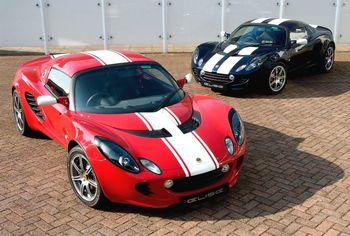.
Lotus Elise

The Lotus Elise is a roadster conceived in early 1994 and released in September 1995 by the English manufacturer Lotus Cars. The car has a hand finished fiberglass body shell atop its innovative aluminium extrusion frame that provides a rigid platform for the suspension, while keeping weight and production costs to a minimum. The Elise was named after then Lotus' chairman Romano Artioli's granddaughter, "Elisa". The base price on the Lotus Cars website is $ 42,990
Series 2
Announced on October 9th 2000, the Series 2 Elise was a redesigned Series 1 using a slightly modified version of the Series 1 chassis and the same K-series engine with a brand new Lotus-developed ECU.
The design of the body paid homage to the still-born M250 project and was the first Lotus to be designed on computer. The Series 2 Elise is built on the same production line also created for the Vauxhall VX220/Opel Speedster in a newer facility at Hethel. Both cars shared many parts, including the chassis, although they have totally different drivetrains and powerplants. The Vauxhall / Opel version has since ceased production.
The series 2 was also available as a 111S model, with the VVT engine technology. Also released was the Lotus Sport 160, which is a Lotus 111S Series 2 with the additional track handling package. The 111S models were discontinued in 2005.
111R
This Series 2 Elise model comes in European 111R version or a version sold in North America, called the Federal Elise. It is powered by the all-aluminium 189 hp (141 kW) Yamaha-designed, Toyota-produced 2ZZ-GE engine, has a Toyota gearbox and is acclaimed as the best version of the Elise to date, with tremendous performance numbers, with many tests resulting in 0-60 mph in approximately 4.5 s.
The 2005 Lotus Elise was the first to be sold commercially in the United States, in the summer of 2004. Approval for the Elise, however, required intervention by the National Highway Traffic Safety Administration (NHTSA) who provided a three-year exemption for the car, as it had failed to meet US bumper regulations. The next-generation Elise, due in 2007, will be required to comply with the rules unless Lotus gets an exemption extension, like it did on multiple occasions with its previous USA distributed car, the Esprit.
This model has been followed up by the 2006 Model Year Elise 111R and SportRacer models.
Series 1
The design philosophy of Lotus is "Performance through low weight", a philosophy first adopted by the founder of Lotus, Colin Chapman. The motto drives Lotus to obtain very high performance with lightweight cars in spite of their relatively modest power outputs, with a strong emphasis on driving purity and dynamics. This concept was taken to an extreme by the London-based engineer Max David.
The result is a sports car which weighed in at less than 680 kg (1500 lb). The production version of the 1996 Lotus Elise tipped the scales at an unprecedented 675 kg (1488 lb). Compare this to a Porsche Boxster which is also considered to be an extremely lightweight sports car but weighs nearly twice as much - 1250 kg (2756 lb).
As a result the Elise's acceleration, braking, cornering, and fuel consumption (all of which are improved by reductions in a car's weight) was nothing short of astonishing in spite of the fact that the engine put out a relatively modest 120 bhp (89 kW). Compare that to 201 bhp (149 kW) produced by the 1997 Porsche Boxster.
Although high-tech, it represented affordable cost of ownership for sports car lovers on a budget who still wanted performance and looks.
111S
The original Elise, called the Series 1 was augmented by a faster edition called the 111S, named after the Lotus type-number of the Elise - M111. The 111S was introduced in early 1999 and contained the VVC engine, a Rover K series with a modified head and VVT type technology rather than the standard Rover 1.8 L K-series unit. It also had more padding in the seats to the horror of purists and the relief of those with nerve endings in their bottoms.
340R
In 2000, the 340R limited edition model, based on a Series 1 Elise was introduced. This roofless car was a special edition, limited to only 340 cars being built.
Gallery
External links
- Lotus Official Site
- Lotus USA Official Site
- Lotus Elise America unofficial message board
- SELOC, a not-for-profit global internet-based Lotus Enthusiasts Club, with a very active message board
- "How the Lotus Elise Works" from Howstuffworks
This page uses content from Wikipedia; see Lotus Elise, which includes these contributors.



